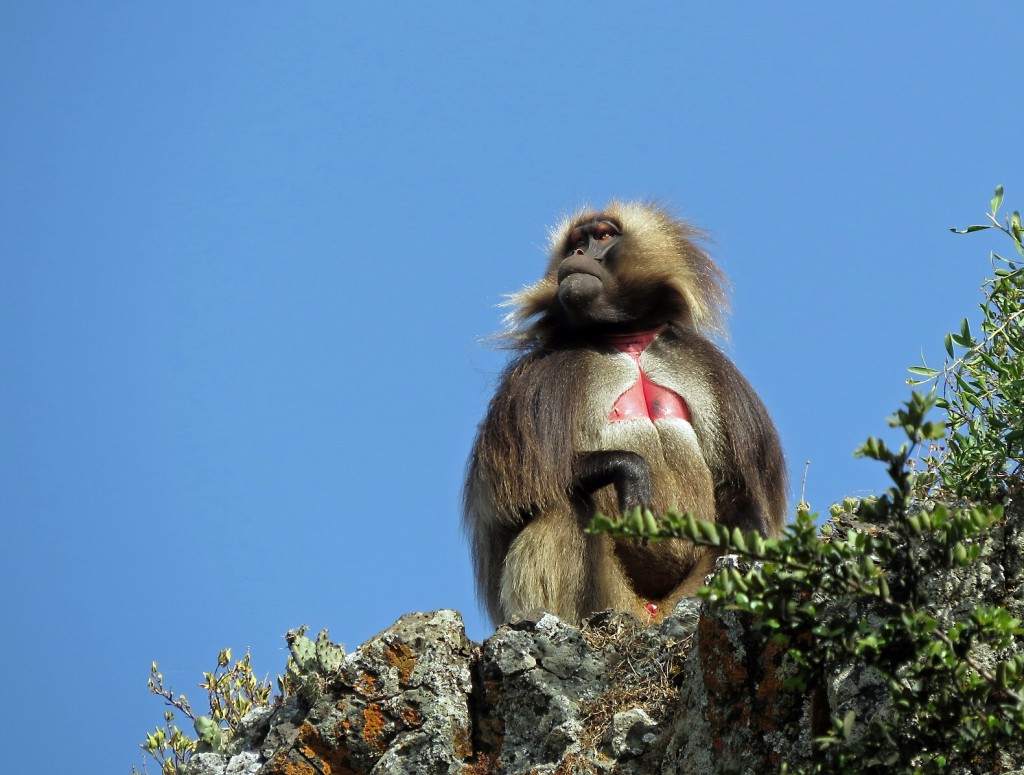Judyth Swift travelled on our 'Ethiopia's Endemic Birds' tour and submitted this entry to our writing competition.
Gelada by Judyth Swift
A Lammergeier passes me at eye level. This does it for me! I am standing on the edge of a cliff, the sides of which drop a kilometre to the valley below. My fear of heights is temporarily conquered – I am completely focused on the massive bird soaring in front of me: the Bearded Vulture, Gypaetus barbatus. Rarely seen away from mountain massifs and usually at high altitude. I have never seen one of these vultures in Europe, but now I am eye to eye with this unique raptor in Ethiopia – admiring a masterful flier of truly impressive proportions, with long narrow wings, long distinctly wedged tail, so light and agile in flight! Its upper parts appear shiny, almost silvery from the reflected light, yet the mantle is dark, and contrasts with the white head of the adult bird. I can see the black lores and the beard! The wings appear all dark from below, the body is the colour of deep ochre (I'm told from contact with iron oxide at the breeding cliffs).
I suddenly realise I'm holding my breath ... and let it out in a whoosh! My last day in Africa and this is the highlight of the Ethiopian trip for me – yet, in honesty, only one of many fantastic experiences I've had in the previous eight days I've been in the country. With its spectacular scenery, fascinating geology and history, extensive bird list (with up to 37 endemics), endemic mammals such as the Mountain Nyala (Dinsho Lodge) and Ethiopian Wolf (the Sanetti Plateau in the Bale Mountains) and friendly people, Ethiopia is truly a wonderful place to visit. And if you like birds of prey, like me ... well, what can I say!
During the course of the trip I ticked off 26 species of raptor – including six vultures and six eagles – plus six species of owls. Memorable moments: watching an African Hawk-eagle mob a Verreaux's Eagle (over Debre Libanos monastery); photographing Tawny, Steppe and Greater Spotted Eagles sitting close together on the ground (Sululta Plains); finding a Northern White-faced Owl by torchlight (Awash National Park); climbing down a steep rocky slope to get a look at an Abyssinian Owl roosting in a tree (Gaysay Valley in the Bale Mountains); watching Hooded, Ruppell's and White-backed Vultures feeding on a horse carcass by the side of the road (somewhere south of Shalla in the Rift Valley), later joined by a single Lappet-faced Vulture which circled overhead for 10 minutes before dropping in to join the crowd.
Now back to the last day of the trip and the cliff top viewpoint: I am standing on the precipitous lip of the Jemma Valley (near Debre Libanos Monastery in the Ethiopian Highlands). The Lammergeier is floating on the thermals about 20 metres out: I manage to reel off a dozen or so photos before this bird flies out of view. Then I turn and grin at my husband, indeed at everyone! What could be better than this! We walk a couple of hundred metres along the ridge of the gorge to the so-called Portuguese bridge and spot Blue Rock Thrush, Ruppell's Black Chat, Mocking Cliff Chat and White-winged Cliff Chat, White-billed Starling and Fan-tailed Raven. In the rock pools below the bridge a number of Gelada Baboons are drinking and having a wash – this is Theropithecus gelada, another one of the target endemics I came to Ethiopia to see! My heart races for the second time that hour: the bleeding heart baboon (though actually not a true baboon at all), is found only in the Ethiopian highlands – and there are a fair number of these primates in the Debre Libanos area.
The huge male Gelada climbs slowly up the rocky hillside next to the bridge and squats down on the ridge and begins plucking and munching on grasses. There are two things that strike me: the heart-shaped crimson patch of hairless skin on his chest (which apparently indicates that one or more females are in oestrus) is much like a tattoo on a human male, and his fatty rear end (adapted to allow Geladas to spend most of their day sitting down) looks very much like human buttocks. I look at my husband and he smiles – perhaps daring me to make the obvious comparison.
Read more about our 'Ethiopia's Endemic Birds' holiday.



 Loading search...
Loading search...
